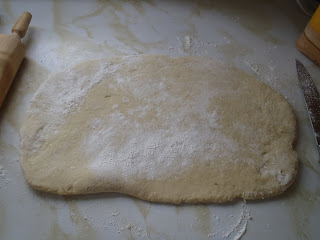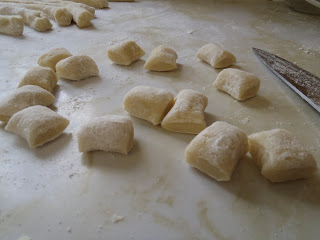-Tuco Ramírez in The Good, The Bad, and The Ugly
The importance of potatoes to my family was a slow revelation. I always knew from off-hand, quietly resentful remarks that when my parents were young they spent a lot of time tending to potato patches. Only recently did I fully understand the role potatoes played in their lives.
We usually consider bread to be the embodiment of simple, gratifying food. References to bread in European history, mythology, and religion are too numerous to count, but here are some highlights. Ample supplies of bread have often been the foundation of political stability. During the long period of decline, Roman emperors are said to have placated the masses with "bread and circuses," that is, by giving away bread and hosting spectacles like the gladiatorial fights. On the other hand, bread shortages incited riots during the French Revolution, which prompted Marie Antoinette's infamous proposal: "Let them eat cake". The Bible is replete with references to bread, where it is the main symbol of bodily nourishment. The two most notable references are in the Lord's prayer ("Give us this day our daily bread") and the breaking of bread during the last supper before Christ's death, which became the central sacrament of the Christian faith, in the form of communion.
Potatoes, being native to America, were unknown to Europe until the sixteenth century, weren't widely eaten there until the nineteenth century, and even then were considered peasant food. They don't have the benefit of biblical references, to say the least.
My parents grew up on farms in Ontario, and while they baked bread at home, potatoes were the staff of life. My mom ate potatoes twice a day almost every day of her childhood, usually fried potatoes with lunch and boiled potatoes with dinner.
 Her family grew them in huge quantities to last the winter. They were stored in the cool basement in crates with three solid walls and a fourth wall made out of slats stacked and held in place by grooves. The potatoes were sprinkled with lime (the chemical, not the fruit) to prevent rot.
Her family grew them in huge quantities to last the winter. They were stored in the cool basement in crates with three solid walls and a fourth wall made out of slats stacked and held in place by grooves. The potatoes were sprinkled with lime (the chemical, not the fruit) to prevent rot.With this in mind, I have a dish to celebrate the potato: a dish befitting the nourishing, comforting, hearty character of the tuber. This ain't duchess potatoes or Vichysoisse. I'm talking about a potato broth with dumplings.
Potato Broth with Dumplings
Conversations about potato dishes usually focus on texture (the ideal French fry has a crisp exterior and fluffy interior, the ideal mashed potatoes are smooth but not gummy...) I love this broth because it makes you think about how potatoes taste. Potato skins are used to infuse a vegetable broth with potato flavour, without any of the thick starchiness we associate with potato soups.
Start with the dumplings. The key to pillow-like potato dumplings is to have as little moisture in the potatoes as possible. This way the milled potatoes will require less flour to form a dough, and there will be accordingly less gluten in the finished dumplings. Use low-moisture, starchy potatoes like russets.
Boil or bake the potatoes whole, with the skins on. Once they are cooked through and still hot, peel away the skins in large segments and mill the potatoes. Clouds of steam will escape in the process, ridding the flesh of excess moisture. Spread the milled potatoes on a sheet pan and cool thoroughly to let a maximum of moisture evaporate.
Lay your potato peels on a rack and dry thoroughly in a warm oven.

Once the potatoes have cooled, add flour and mix until a dough forms. To shape the dumplings, roll the dough flat, cut into strips, then cut the strips into rectangular pillows.




Now the broth. Make a simple vegetable broth by sweating onions, carrots, celery, and a touch(!) of tomato for colour and acidity. Add parsley, bay, and pepper. Cover with cold water and simmer for about an hour. Strain out the vegetables.
Add the crisp potato peels to the vegetable broth and simmer until you can taste the potato and the broth has reduced to a flavoursome concentration. Remove the peels before serving.





What a wonderful informative and personal post. Love the recipe. I find it difficult to make gnocchi and will try this. What do you do with the dehydrated potato skins? Eat them with salt?
ReplyDeleteGrind them up and put them into soups? Just curious. Will you upload plug in so that I can have your new posts delivered into my mailbox?
:)
Valerie
I have a TUBER boner right now
ReplyDeleteHi Valerie - The potato skins were simmered in the vegetable broth. They give the broth a pronounced potato taste. In a good way. I kind of mention it quickly at the end of the post. And I'll look into an RSS feed. We're a little behind the times here at Button Soup.
ReplyDeleteAnd for those that don't know, Chef Donald is alluding to a line from Top Chef, Season Four. A contestant is so excited for an upcoming cook-off he says, "I have a culinary boner." The phrase has since become part of the day-to-day vernacular of line-cooks the world over. Including myself. Though I don't usually say it around civilians.
Major marks for it simply looking darn tasty. Does lime [the chemical, not the fruit] taste any good?
ReplyDeleteMe, being a fan of urban 'farming', have learned that my fate and that of the potato are intertwined. Can't grow grain on a city lot. Or rice. But potato...
I think lime is calcium hydroxide, which is a little bit caustic. The wintered potatoes that were treated with lime were always washed and peeled, and the peels were discarded.
ReplyDeleteThe broth above would have to be made with potatoes fresh from the garden.
I grew potatoes this year in my version of potato bags. " I bought tarp like bags in a variety of colors from the dollar store and cut the zippered portion out of the top and poked holes for drainage. I was too cheap to buy the $12 ones you can order on line and it was a bit late to be planting. The seed potatoes were a varitey pack that Tara had gotten at Green eggs and Ham. We harvested three bags yesterday and only got an ice cream pail of potatoes but it was fun. The last bag I harvested had about 20 small potatoes in it and they were fantastic tasting boiled within half an hour of picking. I have a few bags left to harvest. The little purple ones are really hard to see when harvesting but Tara claims they are really tasty. If you want to learn about planting in potato bags google it and watch the U-tub video that comes up. There is a Scot demonstrating. I'm sure I watched it five times just so I could listen to his accent.
ReplyDelete:D
ReplyDeleteI must try this!
thanks for sharing :)